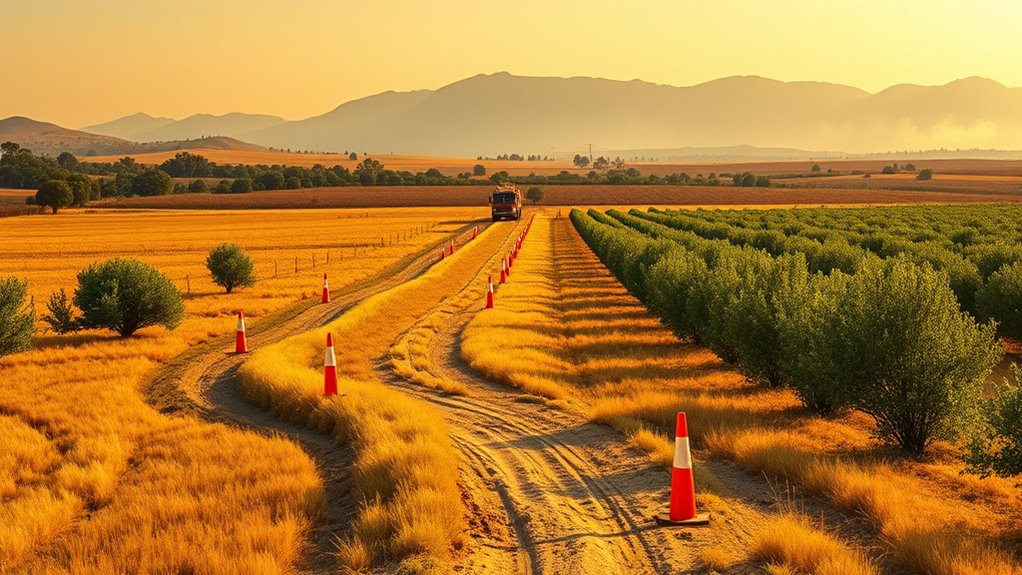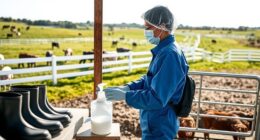To create effective wildfire evacuation routes for your farm, assess your land’s vulnerability, identify multiple accessible routes, and mark them clearly on maps. Regularly practice drills with staff, ensure vehicles are ready, and select safe zones away from flammable materials. Coordinate with local emergency services and keep communication channels open. If you follow these steps, you’ll be well-prepared for any fire threats. More detailed guidance can help you strengthen your plan even further.
Key Takeaways
- Identify and regularly update multiple accessible evacuation routes free from obstacles and hazards.
- Map routes with landmarks, key turn points, and verify vehicle readiness for quick deployment.
- Designate safe zones and shelter areas away from flammable materials, ensuring easy access and clear signage.
- Coordinate with emergency services, sharing risk assessments, routes, and communication protocols.
- Conduct frequent drills to practice evacuation procedures, improve response times, and ensure staff familiarity.
Assessing Your Farm’s Vulnerability to Wildfires

Understanding your farm’s vulnerability to wildfires is the first step in developing an effective emergency plan. You need to evaluate how susceptible your land is to fire spread, considering factors like local climate, terrain, and nearby vegetation. Firebreak planning plays a vital role here; identify natural or man-made barriers to slow or stop fire movement. Vegetation management is equally important—regularly clear dry brush, remove dead trees, and trim overgrown plants to reduce fuel. Focus on creating defensible spaces around buildings and critical infrastructure. Additionally, understanding high-risk areas based on your landscape can help prioritize mitigation efforts. Conducting a thorough risk assessment allows you to identify vulnerabilities more accurately. Incorporating vegetation management strategies can significantly reduce fuel loads and fire risk. By assessing these elements, you gain a clearer picture of your farm’s wildfire risks. This proactive approach helps you prioritize actions that minimize fire danger and protect your property when fire seasons intensify.
Mapping Out Wildfire Evacuation Routes

Creating clear and well-planned wildfire evacuation routes is crucial to guarantee your safety and that of your farm’s personnel and animals. Start by analyzing your farm’s layout and the wildfire risk areas. Identify multiple routes that lead away from high-risk zones, ensuring they’re accessible and free of obstacles. Mark these routes on maps, noting landmarks and key turn points for easy navigation during an emergency. Consider the size of your farm and the number of personnel and animals you need to evacuate. Regularly review and update your evacuation routes to account for changes in terrain, vegetation, or wildfire behavior. Understanding your farm’s fire risk zones can help prioritize the most effective evacuation paths. Incorporating powerful persuasive words into your communication and signage can significantly improve response times during an emergency. Well-mapped evacuation routes help prevent confusion and delays, enabling swift action when wildfire risk escalates and ensuring everyone can reach safety efficiently. Additionally, conducting drills and simulations can prepare your team to respond quickly and confidently in real wildfire scenarios. Performing these regular practice exercises enhances emergency preparedness, ensuring that everyone knows their role when it matters most.
Identifying Safe Zones and Shelter Areas

After mapping out evacuation routes, the next step is to pinpoint safe zones and shelter areas where you and your team can seek refuge during a wildfire. Safe zones are open spaces away from flammable materials, providing a temporary refuge if evacuation becomes impossible. Shelter areas are structures specifically designed to protect you from heat, smoke, and flames, such as reinforced barns or designated fire-resistant buildings. Identify these locations in advance, ensuring they are accessible and well-marked. Make sure everyone on your farm knows where they are and how to reach them quickly. Regularly inspect and maintain these safe zones and shelter areas to ensure they remain viable during an emergency. Properly identified safe zones and shelter areas are critical to safeguarding your team and property.
Coordinating Evacuation With Local Emergency Services

Have you established clear communication channels with your local emergency services? This is essential for effective wildfire evacuation coordination. To strengthen this partnership, consider these steps:
Establish clear communication with emergency services for effective wildfire evacuation planning.
- Share your farm’s wildfire insurance details and risk assessments.
- Coordinate firebreak maintenance schedules to ensure all parties understand access points.
- Develop a shared evacuation plan, including routes and shelter locations.
- Regularly update emergency services about changes in farm operations or hazards.
- Establish local knowledge of terrain and access routes to facilitate faster response times during emergencies.
- Maintain transparency about affiliate relationships to ensure clear and trustworthy communication with authorities.
- Incorporate rustic decor and natural materials into your planning to better understand how terrain and environment can affect evacuation routes. Additionally, engaging with community stakeholders can enhance the overall safety and preparedness of your farm during wildfires.
Communicating the Plan to Staff and Family
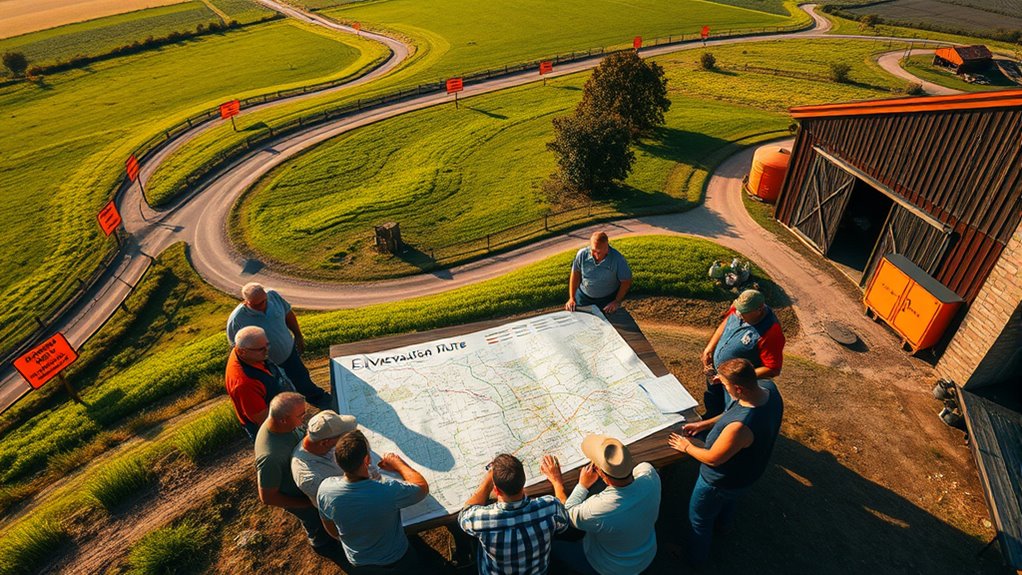
You need to guarantee everyone knows the emergency plan clearly, so establish straightforward communication channels. Regular drills help staff and family stay prepared and confident in their roles. Make sure emergency contact information is up-to-date and accessible to everyone involved. Utilizing clear and consistent messaging ensures that all parties understand their responsibilities during an emergency. Additionally, understanding the importance of privacy and cookie management can help tailor communication methods to respect individual preferences and enhance overall effectiveness. Incorporating effective space organization can further reinforce understanding and retention of the emergency procedures, which is essential for effective creative storytelling for branding in crisis situations.
Clear Communication Channels
Effective communication is essential to guarantee everyone on the farm understands the emergency plan. You must establish clear communication channels to avoid confusion during a wildfire. First, identify potential communication barriers, like language differences or signal issues, and address them proactively. Second, leverage technology solutions such as group messaging apps, radios, or alert systems to reach everyone quickly. Third, assign specific roles for relaying information, ensuring messages are consistent and timely. Fourth, create a backup plan, like physical notes or designated messengers, in case technology fails. By streamlining communication and reducing barriers, you ensure that staff and family stay informed and prepared when it matters most. Clear channels save lives during emergencies. Additionally, understanding asset division principles can help in planning for future resource allocation and recovery efforts after a wildfire.
Regular Emergency Drills
Regular emergency drills are essential for ensuring that everyone on the farm knows how to respond quickly and correctly during a wildfire. Practicing the plan helps identify gaps, such as whether fire resistant fencing is effective or if emergency supply kits are accessible. During drills, assign clear roles to staff and family members, and walk through the evacuation routes, emphasizing safe zones and escape routes. Use these opportunities to review communication procedures, ensuring everyone knows how to contact emergency services and relay updates. Repetition builds confidence and reduces panic in real situations. Regular drills also reinforce the importance of maintaining fire resistant fencing and keeping emergency supply kits stocked and accessible, so you’re prepared when it matters most. Incorporating auditory processing considerations into your training can improve how staff and family members interpret and respond to emergency alarms and instructions. Additionally, practicing with emergency communication devices ensures that all team members can effectively relay information during a crisis. Conducting these drills periodically helps maintain readiness and keeps safety protocols fresh in everyone’s minds. Regularly reviewing evacuation routes can also help identify potential obstacles or hazards that may impede a swift exit during an emergency. Engaging the entire team in training exercises fosters a culture of safety and preparedness across the farm.
Family Emergency Contacts
How can everyone on the farm stay connected during an emergency? The key is establishing clear communication networks and sharing family emergency contacts. First, create a list of reliable contacts, including family members, neighbors, and emergency services. Second, make certain each person has access to this list, whether digitally or physically. Third, designate a primary communication method, like cell phones or walkie-talkies, to keep everyone connected. Fourth, regularly update these contacts and practice how to use the communication networks during drills. Sharing family emergency contacts ensures quick coordination during wildfires or other crises. This way, everyone knows who to call and how to reach each other, helping to keep your farm safe and everyone informed when it counts most.
Preparing Transportation and Equipment for Evacuations
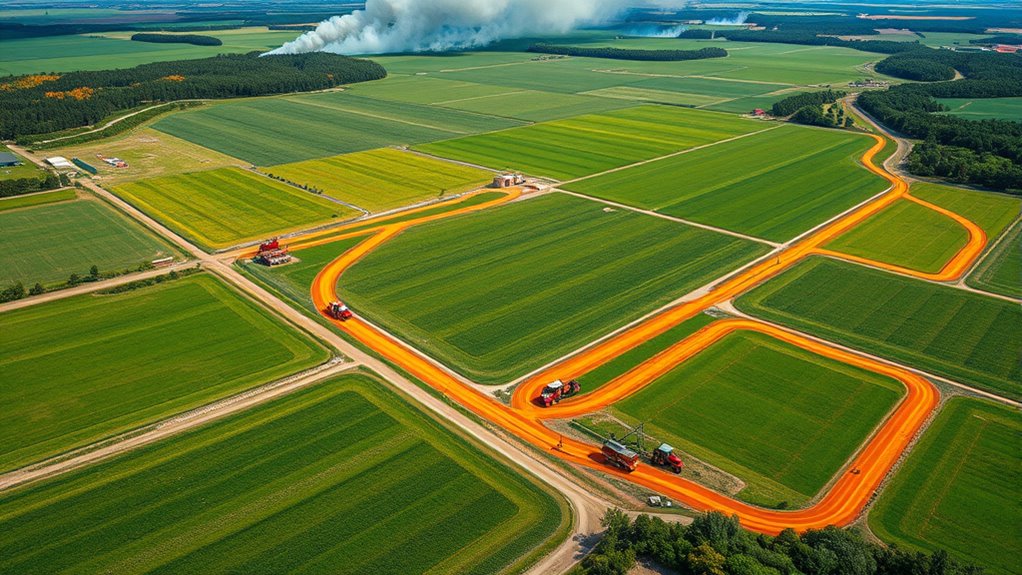
To guarantee a smooth evacuation during an emergency, you need to thoroughly prepare your transportation and equipment in advance. Focus on transportation logistics by mapping out routes and ensuring vehicles are ready to go. Check that all trucks, trailers, and other transport modes are in good working order, and keep fuel tanks topped off. Regular equipment maintenance is vital—inspect and service engines, tires, brakes, and safety features to prevent breakdowns during a crisis. Keep emergency kits, straps, and tools accessible in your vehicles. Practice loadings and loading procedures so you can evacuate quickly when needed. Staying organized and proactive minimizes delays, helping you evacuate efficiently and safely when wildfire threats escalate.
Protecting Livestock and Crops During Emergencies
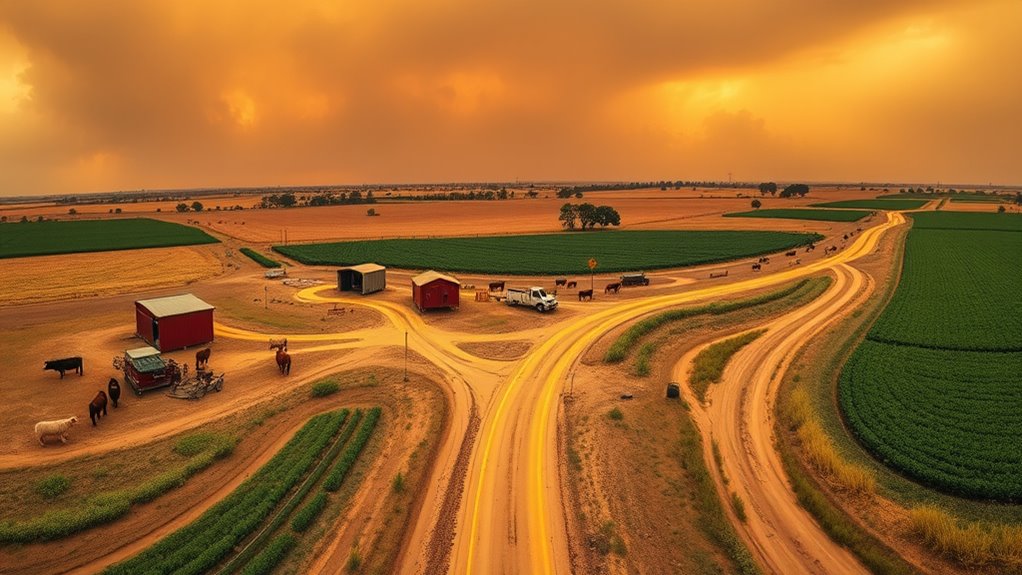
Effective protection of livestock and crops during emergencies requires proactive planning and swift action. To ensure their safety, you should:
- Secure livestock health by maintaining up-to-date vaccinations and health records.
- Prepare temporary shelters or safe zones to move animals quickly if needed.
- Safeguard crop storage by using fire-resistant materials and storing valuables in safe locations.
- Keep emergency supplies, including water, feed, and first aid, readily accessible.
Practicing and Updating Your Wildfire Evacuation Plan
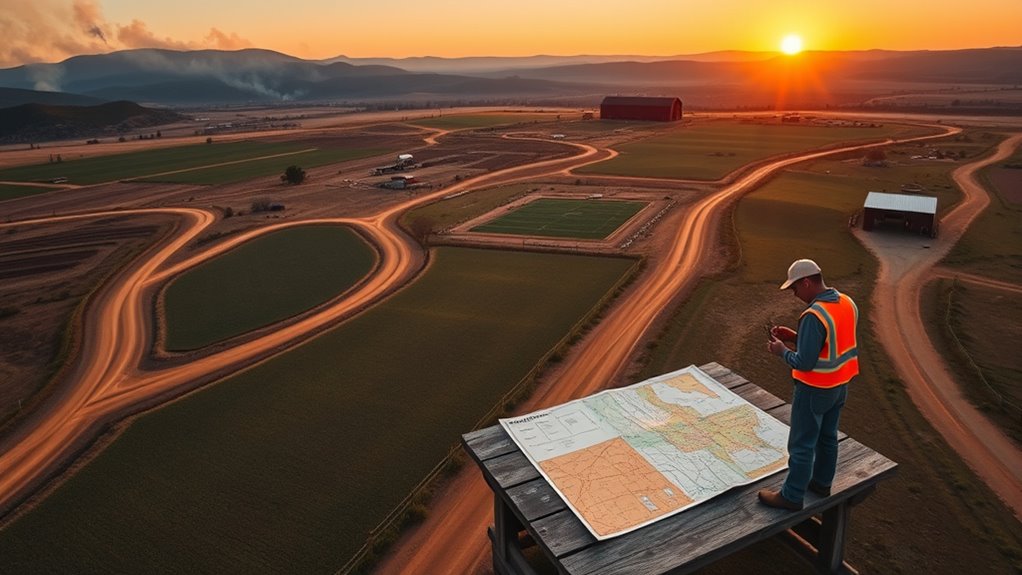
Practicing and regularly updating your wildfire evacuation plan guarantees you can respond quickly and confidently when an emergency arises. Consistent wildfire preparedness drills help identify gaps in your plan and improve emergency communication. By rehearsing your evacuation routes, you ensure everyone understands their roles and knows where to go. Review your plan annually or after significant farm changes. Use these drills to test your communication methods and update contact info. Consider this table to track your plan’s components:
| Component | Status (Updated/Needs Review) |
|---|---|
| Evacuation routes | |
| Emergency contact info | |
| Livestock evacuation | |
| Emergency supplies | |
| Communication procedures |
Keeping your plan current guarantees swift action during wildfire threats, minimizing risk to your farm.
Post-Evacuation Procedures and Recovery Strategies
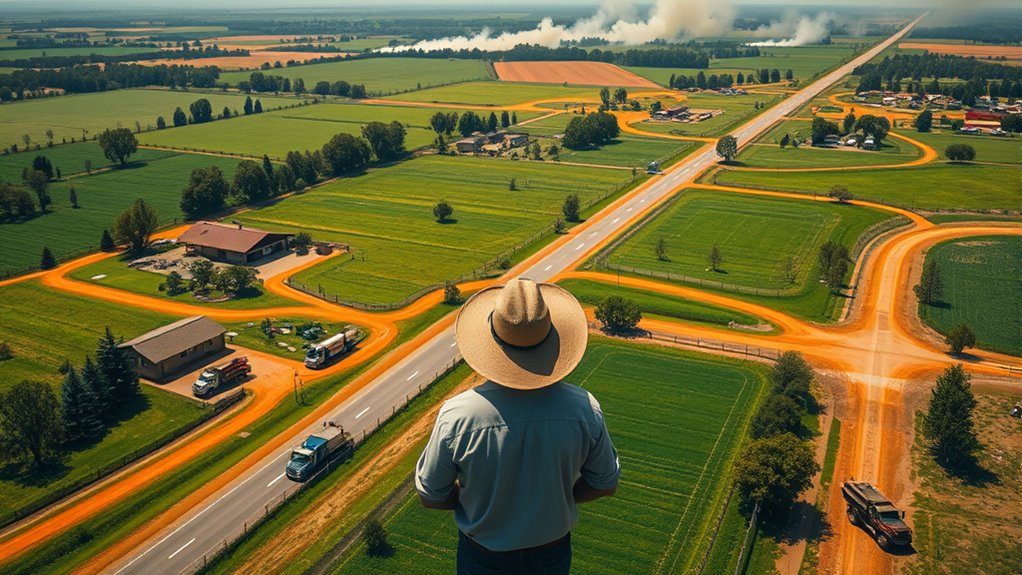
After you evacuate, focus on ensuring everyone’s safety and checking for injuries. Once it’s safe, start evaluating damage and planning how to restore farm operations quickly. Clear procedures now will make recovery smoother and help you get back to work faster.
Post-Evacuation Safety Measures
Once you’ve evacuated the farm, prioritizing safety remains crucial as you assess the situation and begin recovery. To reduce wildfire risk and guarantee safety, follow these steps:
- Check yourself and others for injuries, providing first aid if needed.
- Avoid dangerous areas or unstable structures that could collapse or flare up.
- Stay informed through official updates and avoid returning until authorities declare it safe.
- Continue practicing emergency preparedness by securing essential documents and supplies in case of future incidents.
These measures help prevent further harm, protect your livestock, and support a structured recovery process. Remember, post-evacuation safety isn’t just about immediate actions but also about maintaining awareness and being prepared for any subsequent wildfire threats.
Restoring Farm Operations
Following your evacuation, restoring farm operations begins with evaluating damage and ensuring safety. Carefully inspect buildings, equipment, and fields for fire damage or hazards. Prioritize wildfire prevention by removing combustible materials around structures and maintaining clear firebreaks. Once safety is confirmed, update your farm security to prevent theft or vandalism during vulnerability. Document damages for insurance claims and plan necessary repairs. Reassess water and power supplies, ensuring systems are functional before resuming activities. Communicate with staff and suppliers about your recovery timeline. Implement wildfire prevention measures moving forward to reduce future risks. Restoring operations swiftly and safely depends on your thorough assessment, reinforced farm security, and proactive wildfire prevention strategies. This approach helps minimize downtime and safeguards your farm’s long-term resilience.
Frequently Asked Questions
How Often Should Wildfire Evacuation Routes Be Reviewed and Updated?
You should review and update your wildfire evacuation routes at least once a year. Regular evacuation route maintenance guarantees paths are clear and accessible. Incorporate emergency drill scheduling into your routine to identify any issues and improve response times. Keep your plan current by checking for changes in farm layout, nearby hazards, or new escape routes. Consistent reviews help you stay prepared and ensure everyone knows how to evacuate safely during a wildfire.
What Are Some Common Obstacles That Block Wildfire Evacuation Routes?
You should regularly identify and address obstacles that block wildfire evacuation routes, such as overgrown vegetation or debris. Firebreak maintenance is vital to keep pathways clear, preventing fires from spreading close to escape routes. Additionally, ensuring signage clarity helps guide you quickly during emergencies. Regular inspections and prompt removal of obstructions help maintain safe, accessible routes, reducing evacuation time and increasing safety during wildfires.
How Can Technology Enhance Wildfire Evacuation Planning on Farms?
Imagine wildfire evacuation planning on farms getting a superhero upgrade! You can use drone mapping to scan vast fields instantly, revealing every obstacle and escape route like a bird’s-eye view from a superhero’s perspective. Real-time alerts act like alarm sirens, notifying you instantly of danger, so you can act swiftly. This tech transforms chaos into clarity, saving lives and livestock by making evacuation plans faster, smarter, and more precise.
What Legal Considerations Exist When Establishing Evacuation Routes?
When establishing evacuation routes, you need to consider legal aspects like liability concerns and land ownership. You’re responsible for ensuring routes are safe and clearly marked to avoid legal issues if someone gets injured. Confirm land ownership permissions to prevent disputes, and document your planning process. Being aware of these legal considerations helps protect you and ensures your evacuation plan is compliant with local regulations.
How Do Weather Patterns Influence Wildfire Evacuation Planning?
Think of weather patterns as the wind guiding a flame—constant, unpredictable, and powerful. You must stay alert to climate change effects and seasonal forecasts, which influence wildfire risks. By understanding these patterns, you can adapt evacuation routes proactively, ensuring safety. Planning ahead based on weather trends helps you respond swiftly, saving lives and property when wildfires threaten your farm. Stay informed to keep your escape plan always ready.
Conclusion
Having a solid wildfire evacuation plan might seem like a hassle, but it’s your best defense against disaster. By preparing now, you guarantee your farm, livestock, and family stay safe when fire strikes. It’s easy to think it won’t happen to you, but wildfires are unpredictable. Take action today—review, practice, and update your plan regularly. Your peace of mind and safety depend on it, so don’t wait until it’s too late.

